基本回归
回归(Regression):https://www.tensorflow.org/tutorials/keras/basic_regression
主要步骤:
数据部分
- 获取数据(Get the data)
- 清洗数据(Clean the data)
- 划分训练集和测试集(Split the data into train and test)
- 检查数据(Inspect the data)
- 分离标签(Split features from labels)
- 规范化数据(Normalize the data)
模型部分
- 构建模型(Build the model)
- 检查模型(Inspect the model)
- 训练模型(Train the model)
- 做出预测(Make predictions)
Auto MPG Data Set (汽车MPG数据集)
- mpg(miles per gallon, 每加仑行驶的英里数)
- https://archive.ics.uci.edu/ml/datasets/Auto+MPG
- https://archive.ics.uci.edu/ml/machine-learning-databases/auto-mpg/
Attribute Information:
- 1. mpg: continuous
- 2. cylinders: multi-valued discrete
- 3. displacement: continuous
- 4. horsepower: continuous
- 5. weight: continuous
- 6. acceleration: continuous
- 7. model year: multi-valued discrete
- 8. origin: multi-valued discrete
- 9. car name: string (unique for each instance)
一些知识点
验证集
- - 通常指定训练集的一定比例数据作为验证集。
- - 验证集将不参与训练,并在每个epoch结束后测试的模型的指标,如损失函数、精确度等。
- - 如果数据本身是有序的,需要先手工打乱再指定,否则可能会出现验证集样本不均匀。
回调函数(Callbacks)
回调函数是一个函数的合集,在训练的阶段中,用来查看训练模型的内在状态和统计。
在训练时,相应的回调函数的方法就会被在各自的阶段被调用。
一般是在model.fit函数中调用callbacks(参数为callbacks,必须输入list类型的数据)。
简而言之,Callbacks用于指定在每个epoch开始和结束的时候进行哪种特定操作。
EarlyStopping
EarlyStopping是Callbacks的一种,可用来加快学习的速度,提高调参效率。
使用一个EarlyStopping回调来测试每一个迭代的训练条件,如果某个迭代过后没有显示改进,自动停止训练。
- https://keras.io/zh/callbacks/#earlystopping
- https://www.tensorflow.org/api_docs/python/tf/keras/callbacks/EarlyStopping
结论(conclusion)
- - 均方误差(MSE)是一种常见的损失函数,可用于回归问题。
- - 用于回归和分类问题的损失函数不同,评价指标也不同,常见的回归指标是平均绝对误差(MAE)。
- - 当输入的数据特性包含不同范围的数值,每个特性都应该独立为相同的范围。
- - 如果没有太多的训练数据时,有一个技巧就是采用包含少量隐藏层的小型网络,更适合来避免过拟合。
- - EarlyStopping是一个防止过度拟合的实用技巧。
示例
脚本内容
GitHub:https://github.com/anliven/Hello-AI/blob/master/Google-Learn-and-use-ML/3_basic_regression.py
1 # coding=utf-8 2 import tensorflow as tf 3 from tensorflow import keras 4 from tensorflow.python.keras import layers 5 import matplotlib.pyplot as plt 6 import pandas as pd 7 import seaborn as sns 8 import pathlib 9 import os 10 11 os.environ['TF_CPP_MIN_LOG_LEVEL'] = '2' 12 print("# TensorFlow version: {} - tf.keras version: {}".format(tf.VERSION, tf.keras.__version__)) # 查看版本 13 14 # ### 数据部分 15 # 获取数据(Get the data) 16 ds_path = str(pathlib.Path.cwd()) + "\datasets\auto-mpg\" 17 ds_file = keras.utils.get_file(fname=ds_path + "auto-mpg.data", origin="file:///" + ds_path) # 获得文件路径 18 column_names = ['MPG', 'Cylinders', 'Displacement', 'Horsepower', 'Weight', 'Acceleration', 'Model Year', 'Origin'] 19 raw_dataset = pd.read_csv(filepath_or_buffer=ds_file, # 数据的路径 20 names=column_names, # 用于结果的列名列表 21 na_values="?", # 用于替换NA/NaN的值 22 comment=' ', # 标识着多余的行不被解析(如果该字符出现在行首,这一行将被全部忽略) 23 sep=" ", # 分隔符 24 skipinitialspace=True # 忽略分隔符后的空白(默认为False,即不忽略) 25 ) # 通过pandas导入数据 26 data_set = raw_dataset.copy() 27 print("# Data set tail: {}".format(data_set.tail())) # 显示尾部数据 28 29 # 清洗数据(Clean the data) 30 print("# Summary of NaN: {}".format(data_set.isna().sum())) # 统计NaN值个数(NaN代表缺失值,可用isna()和notna()来检测) 31 data_set = data_set.dropna() # 方法dropna()对缺失的数据进行过滤 32 origin = data_set.pop('Origin') # Origin"列是分类不是数值,转换为独热编码(one-hot encoding) 33 data_set['USA'] = (origin == 1) * 1.0 34 data_set['Europe'] = (origin == 2) * 1.0 35 data_set['Japan'] = (origin == 3) * 1.0 36 data_set.tail() 37 print("# Data set tail: {}".format(data_set.tail())) # 显示尾部数据 38 39 # 划分训练集和测试集(Split the data into train and test) 40 train_dataset = data_set.sample(frac=0.8, random_state=0) 41 test_dataset = data_set.drop(train_dataset.index) # 测试作为模型的最终评估 42 43 # 检查数据(Inspect the data) 44 sns.pairplot(train_dataset[["MPG", "Cylinders", "Displacement", "Weight"]], diag_kind="kde") 45 plt.figure(num=1) 46 plt.savefig("./outputs/sample-3-figure-1.png", dpi=200, format='png') 47 plt.show() 48 plt.close() 49 train_stats = train_dataset.describe() # 总体统计数据 50 train_stats.pop("MPG") 51 train_stats = train_stats.transpose() # 通过transpose()获得矩阵的转置 52 print("# Train statistics: {}".format(train_stats)) 53 54 # 分离标签(Split features from labels) 55 train_labels = train_dataset.pop('MPG') # 将要预测的值 56 test_labels = test_dataset.pop('MPG') 57 58 59 # 规范化数据(Normalize the data) 60 def norm(x): 61 return (x - train_stats['mean']) / train_stats['std'] 62 63 64 normed_train_data = norm(train_dataset) 65 normed_test_data = norm(test_dataset) 66 67 68 # ### 模型部分 69 # 构建模型(Build the model) 70 def build_model(): # 模型被包装在此函数中 71 model = keras.Sequential([ # 使用Sequential模型 72 layers.Dense(64, activation=tf.nn.relu, input_shape=[len(train_dataset.keys())]), # 包含64个单元的全连接隐藏层 73 layers.Dense(64, activation=tf.nn.relu), # 包含64个单元的全连接隐藏层 74 layers.Dense(1)] # 一个输出层,返回单个连续的值 75 ) 76 optimizer = tf.keras.optimizers.RMSprop(0.001) 77 model.compile(loss='mean_squared_error', # 损失函数 78 optimizer=optimizer, # 优化器 79 metrics=['mean_absolute_error', 'mean_squared_error'] # 在训练和测试期间的模型评估标准 80 ) 81 return model 82 83 84 # 检查模型(Inspect the model) 85 mod = build_model() # 创建模型 86 mod.summary() # 打印出关于模型的简单描述 87 example_batch = normed_train_data[:10] # 从训练集中截取10个作为示例批次 88 example_result = mod.predict(example_batch) # 使用predict()方法进行预测 89 print("# Example result: {}".format(example_result)) 90 91 92 # 训练模型(Train the model) 93 class PrintDot(keras.callbacks.Callback): 94 def on_epoch_end(self, epoch, logs): 95 if epoch % 100 == 0: 96 print('') 97 print('.', end='') # 每完成一次训练打印一个“.”符号 98 99 100 EPOCHS = 1000 # 训练次数 101 102 history = mod.fit(normed_train_data, 103 train_labels, 104 epochs=EPOCHS, # 训练周期(训练模型迭代轮次) 105 validation_split=0.2, # 用来指定训练集的一定比例数据作为验证集(0~1之间的浮点数) 106 verbose=0, # 日志显示模式:0为安静模式, 1为进度条(默认), 2为每轮一行 107 callbacks=[PrintDot()] # 回调函数(在训练过程中的适当时机被调用) 108 ) # 返回一个history对象,包含一个字典,其中包括训练期间发生的情况(training and validation accuracy) 109 110 111 def plot_history(h, n=1): 112 """可视化模型训练过程""" 113 hist = pd.DataFrame(h.history) 114 hist['epoch'] = h.epoch 115 print(" # History tail: {}".format(hist.tail())) 116 117 plt.figure(num=n, figsize=(6, 8)) 118 119 plt.subplot(2, 1, 1) 120 plt.xlabel('Epoch') 121 plt.ylabel('Mean Abs Error [MPG]') 122 plt.plot(hist['epoch'], hist['mean_absolute_error'], label='Train Error') 123 plt.plot(hist['epoch'], hist['val_mean_absolute_error'], label='Val Error') 124 plt.ylim([0, 5]) 125 126 plt.subplot(2, 1, 2) 127 plt.xlabel('Epoch') 128 plt.ylabel('Mean Square Error [$MPG^2$]') 129 plt.plot(hist['epoch'], hist['mean_squared_error'], label='Train Error') 130 plt.plot(hist['epoch'], hist['val_mean_squared_error'], label='Val Error') 131 plt.ylim([0, 20]) 132 133 filename = "./outputs/sample-3-figure-" + str(n) + ".png" 134 plt.savefig(filename, dpi=200, format='png') 135 plt.show() 136 plt.close() 137 138 139 plot_history(history, 2) # 可视化 140 141 # 调试 142 model2 = build_model() 143 early_stop = keras.callbacks.EarlyStopping(monitor='val_loss', 144 patience=10) # 指定提前停止训练的callbacks 145 history2 = model2.fit(normed_train_data, 146 train_labels, 147 epochs=EPOCHS, 148 validation_split=0.2, 149 verbose=0, 150 callbacks=[early_stop, PrintDot()]) # 当没有改进时自动停止训练(通过EarlyStopping) 151 plot_history(history2, 3) 152 loss, mae, mse = model2.evaluate(normed_test_data, test_labels, verbose=0) 153 print("# Testing set Mean Abs Error: {:5.2f} MPG".format(mae)) # 测试集上的MAE值 154 155 # 做出预测(Make predictions) 156 test_predictions = model2.predict(normed_test_data).flatten() # 使用测试集中数据进行预测 157 plt.figure(num=4, figsize=(6, 8)) 158 plt.scatter(test_labels, test_predictions) 159 plt.xlabel('True Values [MPG]') 160 plt.ylabel('Predictions [MPG]') 161 plt.axis('equal') 162 plt.axis('square') 163 plt.xlim([0, plt.xlim()[1]]) 164 plt.ylim([0, plt.ylim()[1]]) 165 plt.plot([-100, 100], [-100, 100]) 166 plt.savefig("./outputs/sample-3-figure-4.png", dpi=200, format='png') 167 plt.show() 168 plt.close() 169 170 error = test_predictions - test_labels 171 plt.figure(num=5, figsize=(6, 8)) 172 plt.hist(error, bins=25) # 通过直方图来展示错误的分布情况 173 plt.xlabel("Prediction Error [MPG]") 174 plt.ylabel("Count") 175 plt.savefig("./outputs/sample-3-figure-5.png", dpi=200, format='png') 176 plt.show() 177 plt.close()
运行结果
C:UsersanlivenAppDataLocalcondacondaenvsmlccpython.exe D:/Anliven/Anliven-Code/PycharmProjects/Google-Learn-and-use-ML/3_basic_regression.py
# TensorFlow version: 1.12.0 - tf.keras version: 2.1.6-tf
# Data set tail:
MPG Cylinders Displacement ... Acceleration Model Year Origin
393 27.0 4 140.0 ... 15.6 82 1
394 44.0 4 97.0 ... 24.6 82 2
395 32.0 4 135.0 ... 11.6 82 1
396 28.0 4 120.0 ... 18.6 82 1
397 31.0 4 119.0 ... 19.4 82 1
[5 rows x 8 columns]
# Summary of NaN:
MPG 0
Cylinders 0
Displacement 0
Horsepower 6
Weight 0
Acceleration 0
Model Year 0
Origin 0
dtype: int64
# Data set tail:
MPG Cylinders Displacement ... USA Europe Japan
393 27.0 4 140.0 ... 1.0 0.0 0.0
394 44.0 4 97.0 ... 0.0 1.0 0.0
395 32.0 4 135.0 ... 1.0 0.0 0.0
396 28.0 4 120.0 ... 1.0 0.0 0.0
397 31.0 4 119.0 ... 1.0 0.0 0.0
[5 rows x 10 columns]
# Train statistics:
count mean std ... 50% 75% max
Cylinders 314.0 5.477707 1.699788 ... 4.0 8.00 8.0
Displacement 314.0 195.318471 104.331589 ... 151.0 265.75 455.0
Horsepower 314.0 104.869427 38.096214 ... 94.5 128.00 225.0
Weight 314.0 2990.251592 843.898596 ... 2822.5 3608.00 5140.0
Acceleration 314.0 15.559236 2.789230 ... 15.5 17.20 24.8
Model Year 314.0 75.898089 3.675642 ... 76.0 79.00 82.0
USA 314.0 0.624204 0.485101 ... 1.0 1.00 1.0
Europe 314.0 0.178344 0.383413 ... 0.0 0.00 1.0
Japan 314.0 0.197452 0.398712 ... 0.0 0.00 1.0
[9 rows x 8 columns]
_________________________________________________________________
Layer (type) Output Shape Param #
=================================================================
dense (Dense) (None, 64) 640
_________________________________________________________________
dense_1 (Dense) (None, 64) 4160
_________________________________________________________________
dense_2 (Dense) (None, 1) 65
=================================================================
Total params: 4,865
Trainable params: 4,865
Non-trainable params: 0
_________________________________________________________________
# Example result:
[[0.3783294 ]
[0.17875314]
[0.68095654]
[0.45696187]
[1.4998233 ]
[0.05698915]
[1.4138494 ]
[0.7885587 ]
[0.10802953]
[1.3029677 ]]
....................................................................................................
....................................................................................................
....................................................................................................
....................................................................................................
....................................................................................................
....................................................................................................
....................................................................................................
....................................................................................................
....................................................................................................
....................................................................................................
# History tail:
val_loss val_mean_absolute_error ... mean_squared_error epoch
995 9.350584 2.267639 ... 2.541113 995
996 9.191998 2.195405 ... 2.594836 996
997 9.559576 2.384058 ... 2.576047 997
998 8.791337 2.145222 ... 2.782730 998
999 9.088490 2.227165 ... 2.425531 999
[5 rows x 7 columns]
.........................................................................................
# History tail:
val_loss val_mean_absolute_error ... mean_squared_error epoch
84 8.258534 2.233329 ... 6.221810 84
85 8.328515 2.208959 ... 6.213853 85
86 8.420452 2.224991 ... 6.427011 86
87 8.418247 2.215443 ... 6.178523 87
88 8.437484 2.193801 ... 6.183405 88
[5 rows x 7 columns]
# Testing set Mean Abs Error: 1.88 MPG
Process finished with exit code 0
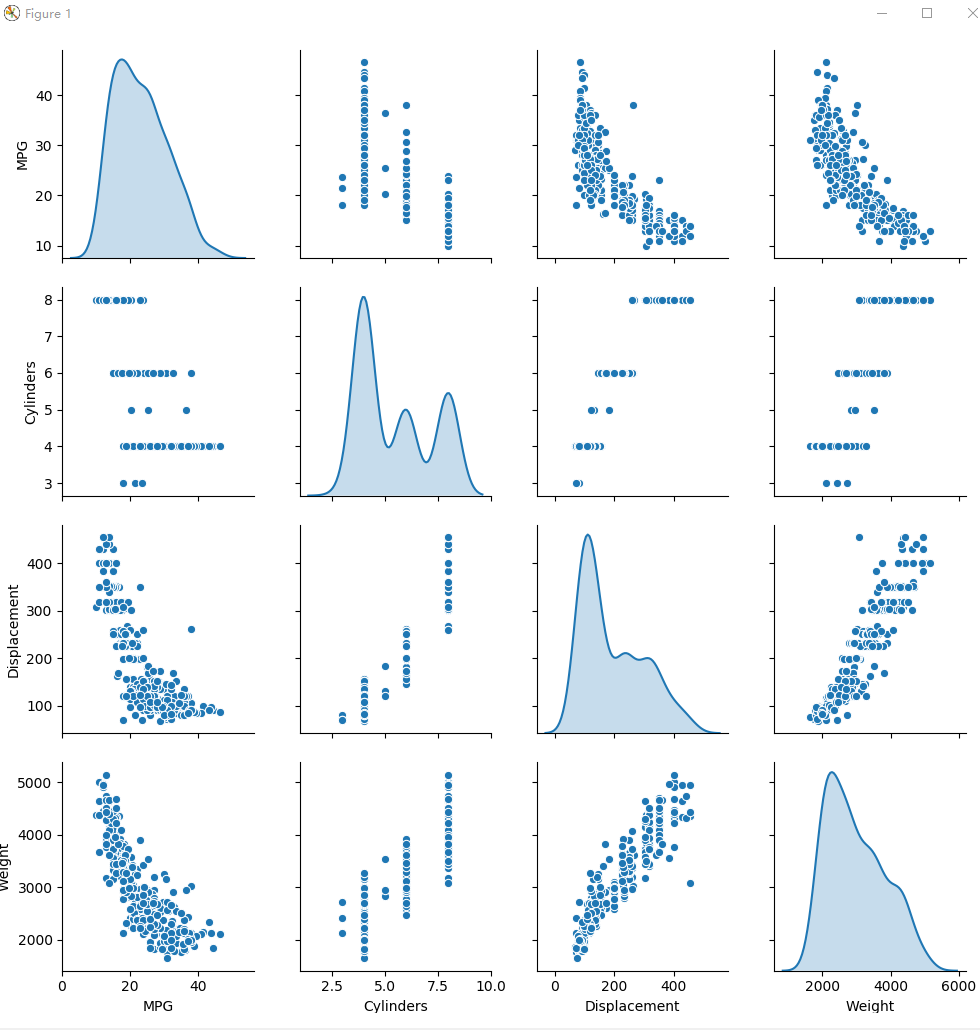
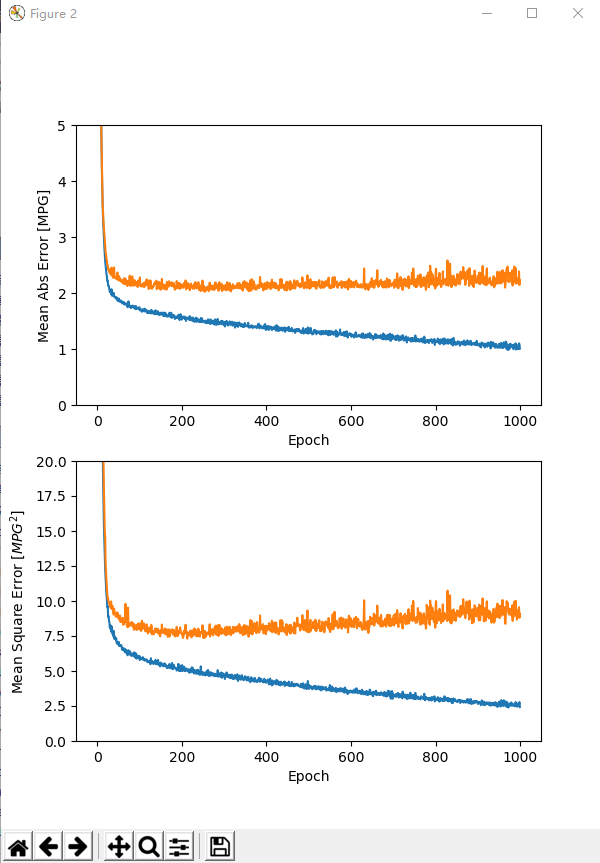
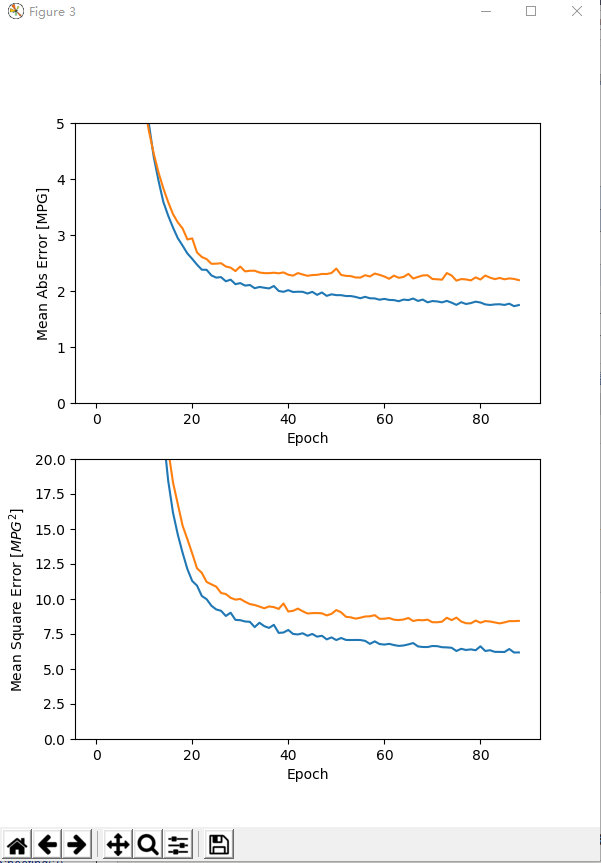
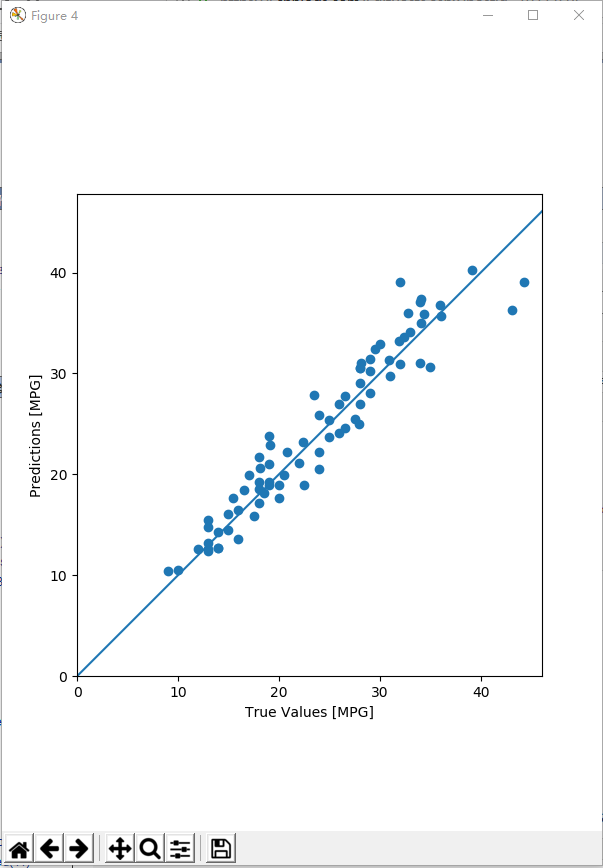
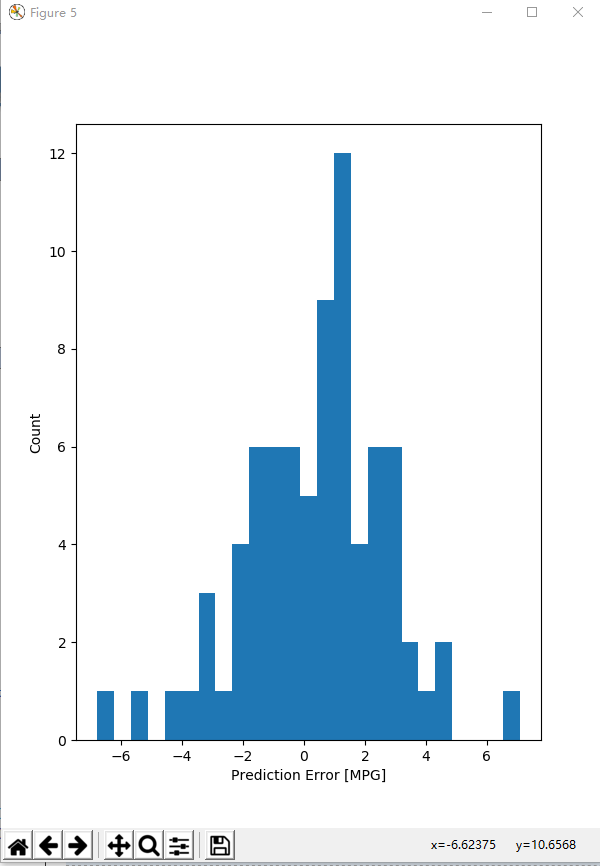
问题处理
问题1:执行“import tensorflow.keras import layers”失败,提示“Unresolved reference”
问题描述
在Anaconda3创建的运行环境中,执行“import tensorflow.keras import layers”失败,提示“Unresolved reference”
处理方法
改写为“from tensorflow.python.keras import layers”
导入包时,需要根据实际的具体位置进行导入。
确认TensorFlow中Keras的实际位置:“D:DownLoadFilesanaconda3envsmlccLibsite-packages ensorflowpythonkeras”。
实际上多了一层目录“python”,所以正确的导入方式为“from tensorflow.python.keras import layers”。
参考信息
https://stackoverflow.com/questions/47262955/how-to-import-keras-from-tf-keras-in-tensorflow
问题2:执行keras.utils.get_file()报错
问题描述
执行keras.utils.get_file("auto-mpg.data", "https://archive.ics.uci.edu/ml/machine-learning-databases/auto-mpg/auto-mpg.data")报错:
Downloading data from https://archive.ics.uci.edu/ml/machine-learning-databases/auto-mpg/auto-mpg.data
Traceback (most recent call last):
......
Exception: URL fetch failure on https://archive.ics.uci.edu/ml/machine-learning-databases/auto-mpg/auto-mpg.data: None -- [WinError 10060] A connection attempt failed because the connected party did not properly respond after a period of time, or established connection failed because connected host has failed to respond
处理方法
“网络”的原因,导致无法下载。手工下载,然后放置在当前目录,从当前目录地址导入数据文件。